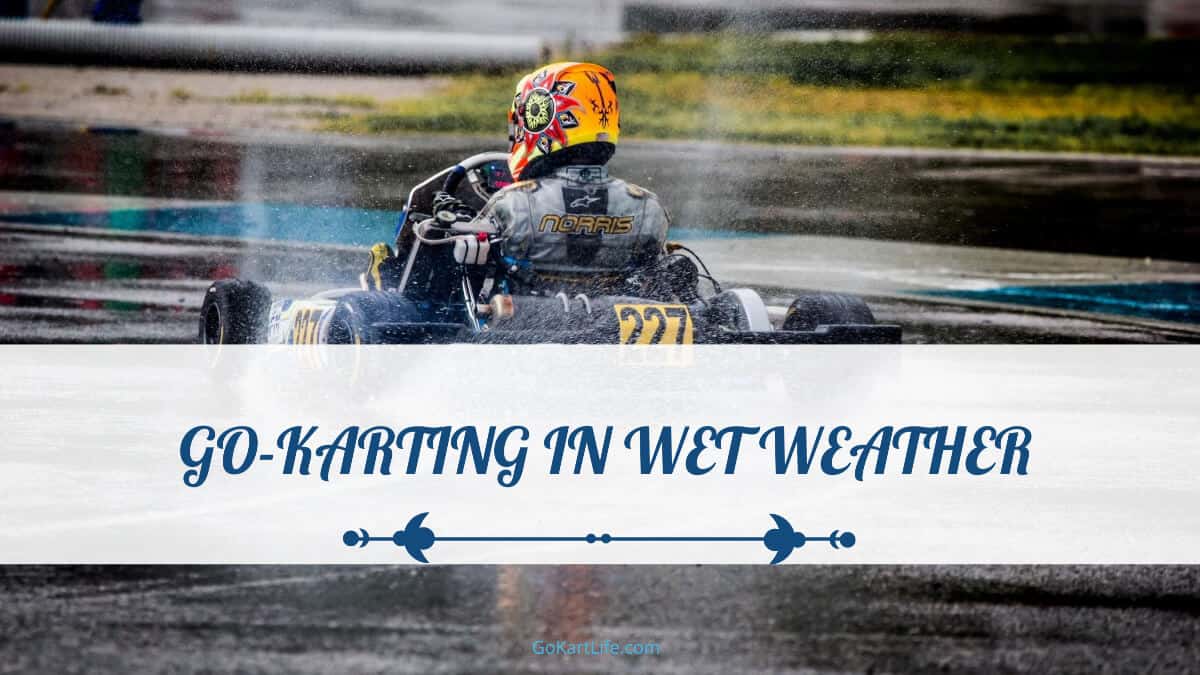Believe it or not, riding a go-kart at breakneck speeds on slick raceways can be hazardous to your health. Plenty of people sustain minor injuries on go-karts under optimal conditions, worsened by a rainy day and wet track.
Knowing how to safely go-kart in wet weather can be the difference between a great day and a trip to the ER.
If the track you’re racing on allows go-karts to run in the rain, there are quite a few ways to make it safer and be a better driver. These include:
- Use the throttle properly, don’t over or under apply it.
- Try to stay off the path other karts have taken.
- Make strong turns; don’t “snatch” the steering wheel.
If you’re a seasoned professional or you’re just an amateur out for a fun day on the track, it can be tricky and dangerous to tackle a wet go-kart track.
Luckily, we’re here with a guide on all the ins and outs of driving go-karts in wet weather. Keep reading to find out all about how you can prepare, some of the dangers to look out for, and how you can stay safe on the track.
If you want to learn more about driving a go-kart visit The Ultimate Guide to Driving a Go-Kart.
Go-Karting in Wet Weather
Go-kart racing in wet weather has significant differences from dry weather go-karting, but pros and amateurs alike find themselves driving like it’s dry without practice.
Driving a go-kart in wet conditions can be thought of similarly to driving a car in wet conditions since the two main elements at play, rubber, and water, and the interaction between them is the same.
Before you ask why anyone would bother go-karting in the rain, consider that many professional races might not be able to be rescheduled due to inclement weather. Hence, the racers have to be able to race in the rain.
Public recreation tracks might stay open for light precipitation as well, so if you’re planning on going for a fun day on the raceway, you might have no choice.
There are several considerations you should make before you hit a wet track for the first time. Among these are the following:
- Extra safety gear is needed.
- Modifications to standard dry track driving techniques
- Advisable speeds for driving
- Number of other drivers on the track
- Suitability of the go-karts to driving on a wet track
- Tire tread left and tire baldness.
Reasons for Wet Weather Go-Karting
Usually, races happen in the rain because there isn’t a choice; the race can’t be rescheduled, or the public fun track doesn’t shut down for light rain.
However, many go-kart enthusiasts enjoy racing in the rain, even though it takes some getting used to. This is because rain requires different driving techniques that some racers find more fun.
Go-karting leagues and organizations are spread throughout the U.S., and if inclement weather hits, there’s a chance they still hold their scheduled races. A little rain won’t stop them from holding their races unless it’s a hurricane or something.
The same thing can be said with many local go-kart race tracks open to the general public; they don’t close down for a little bit of rain (but they will close if there’s snow!)
If you’ve already bought a ticket and it happens to start raining before you go out on the track, you probably don’t want to lose your money, so you’ll need to get ready for some slick racing.
Some people even enjoy racing in the rain, and if you can master the nuances of wet-weather go-kart racing, you’ll find you might be able to beat the most experienced and skilled racers who may not have had as much practice.
Differences From Dry Weather Go-Karting
As you can imagine, driving in wet conditions differs greatly from dry conditions. Some of these differences are summarized in the table below.
| Dry Weather Racing | Wet Weather Racing |
| “Fastest line” around the track is usually the inside corners. | Different “fastest line” around the track – typically towards the outside |
| The rubber on the track gives more grip. | The rubber on the track is slick and removes grip. |
| Fluids on the track aren’t an issue | Visibility is reduced |
| Oil on the track is slick |
Safety
Of course, you’ll probably be concerned about safety while you’re out on the track in the rain. Luckily, go-karts have a shallow center of gravity, so the odds of rolling in one are very low. Simultaneously, a roll can be very dangerous since go-karts don’t have any protection in the form of a roll cage.
This means driving in the rain when conditions are slicker should be done with safety in mind. A few safety tips include the following:
- Keep a greater distance from other cars
- Reduce your speed
- Find the part of the track where less rubber has been laid down
- Make sure you wear your proper personal protective equipment (PPE)
- If you’re not confident, choose a go-kart with a frame around the wheels
- Learn proper wet-track driving techniques (more on that below!)
It may shock you to learn that professional go-karts can reach speeds in excess of 155 mph. While hobbyist carts don’t reach anywhere near that speed, you’ll still be moving at a fast rate around tight turns with minimal protection around you. Therefore, it pays to know how to drive in the wet.
Good Safety Gear
At a minimum, you’ll want to wear the following safety gear for a day out on the wet go-karting track:
- Rib vest to protect your ribs if you crash
- Helmet/head protection – you’ll want to make sure they’re well-ventilated s, o you’re not fogging up, and getting one with a wet weather visor can keep the rain out of your eyes
- Gloves
- Jacket/pants in case of a roll or accident
- Boots – try and find a pair of waterproof boots if you can
- Neck brace – most go-karts have no sort of neck protection or support
- Overalls/wet suit to keep you from getting too wet. Go-karts spray up a lot of water!
The track where you’re racing might have additional requirements or guidelines, so be sure to give them a call and see what they require in terms of protective gear before you show up to the race. Many of them have gear on hand to either borrow or rent, so you don’t need to go out and buy a bunch of equipment if you’re doing it for fun.
Regular Maintenance
Driving safely in the rain as with a regular vehicle means your go-kart should be well-maintained. If you’re a pro and you own your own cart, make sure you’ve kept up with the manufacturer’s recommended maintenance. Keep your cart in tip-top condition, ultimately making it safer to drive at all times.
Wet Weather Tires
This point is worth expanding upon a little bit because of how different wet weather tires are from dry weather ones. It’s helpful to understand how tires work in general so you can have a better idea of why wet weather tires can make a difference. Even though they’re more expensive, they’re worth the extra money if you race in the rain.
In dry conditions, rubber has a very good grip on asphalt, so go-kart tires are wide with a lot of surface area to provide maximum grip. Treads are built into a tire because they add grip due to their shape and depth. In dry conditions, you don’t want a bald tire but one with a wide surface area and good treads.
In wet weather, however, a lot of surface area and contact between rubber and water isn’t good, leading to traction loss. Therefore, wet weather go-kart tires are actually thinner with less surface area to avoid extra slickness.
They’re also not made completely from rubber, but rather a rubber compound. They also have deeper treads for greater water displacement.
Safe Driving Techniques
As mentioned above, several driving techniques will help you be safer if you’re racing in the rain. The table below provides some discussion points for these techniques so you can be sure you get a great time while avoiding accidents or roll-overs.
| Technique | Discussion |
| Reduce speed | Faster speeds with less grip on the track can lead to skids or loss of control of the cart. |
| Stay on the outside of the track | The well-traveled lines of the track, typically around the inside, will have more rubber on their surface from tires constantly being on them. Each track is different, but the outside of the track will give a better grip in the rain because there’s less rubber on it. |
| Purchase wet tires | Especially if you’re professional, wet tires will give better grip because they’re specifically designed for wet-weather racing |
| Strong turns on the wheel | Small, slight turns can cause your go-kart to spin out of control or lose traction. Commit to your turns and make them smooth, don’t use a jerking motion |
| Gas on the turns | Feathering the gas pedal during turns will help keep your rear axle from locking and from losing traction on the turn |
| Use the Curbs | Putting the outside tire over the edge of the curb is called “hooking,” and it can help manage hairpin turns by providing leverage |
Learning and practicing these techniques can put you ahead of the pack while you’re racing and ensure you stay safe. Some of these techniques are admittedly counter-intuitive on their faces; they give some throttle for better traction in corners. We’ll go into specific wet-weather driving techniques below.
Speed in Wet Weather Go-Karting
You’re racing to win if you’re out on the go-kart track. That means you want to balance safety with the fastest possible speed you can muster, so this section is all about the techniques you can use to do that well. We’ve discussed these techniques above, but we’ll go into more detail below about why they work and ways to practice.
Whether you’re an expert or an amateur, the bottom line is that don’t go faster than you’re comfortable doing. Practice will give you the confidence to keep a high speed during wet conditions, but you shouldn’t sacrifice safety for a faster race time. The track employees can give you a good safety brief for driving in the rain safely on their raceway.
Reduce Speed
Putting the pedal on the floor isn’t a great idea when going-karting because of the propensity for wheel spinning in wet conditions. When it’s perfectly dry, you can put the pedal on the floor because of your increased grip and traction. However, when it’s wet, you can’t accelerate too quickly, or the tires won’t grip, and they’ll spin, which can lose speed.
Less is more, in this case, so accelerate lightly when it’s wet out, so your tires maintain traction on the asphalt, and don’t try and max out the throttle. Take your time, and you might pass those less-experienced drivers out there!
Stay to the Outside of the Track
The fastest line through a go-kart track is usually around the corners, which means this spot is driven more. The tires contacting the asphalt leave a little bit behind, creating a “driveline” around the track. In dry conditions, this helps provide more grip to rubber tires, but this is definitely not the case in wet weather.
This line becomes much slicker in rainy conditions, so a good technique is to find the outside of the track or the line that’s not ridden on as much. Each track will be different, so this may take some trial and error, but taking the time to find that line can mean the difference between victory and defeat.
Purchase Wet-Weather Tires
This isn’t a reasonable recommendation for a hobbyist, but if you’re a pro and especially if you own your own kart, purchasing a set of wet-weather tires is a great idea. Not only will you be prepared if it rains, but you’ll also be able to practice on them more often as well.
We’ve already discussed why wet-weather tires exist and how they help you drive better in the rain, but it’s worth mentioning that you’ll still have to apply the other techniques on this list even if your tires are rated for wet weather. They’re not a simple panacea that allows you to wave a magic wand and drive the same way you would on a dry track.
Here’s a quick list of some of the things you should consider when purchasing a set of rain tires for your go-kart:
- Price
- Tread depth
- Tire width
- Material
To learn more about go-kart tires read How to Read Go-Kart Tire Sizes and Understanding Tire Differences.
Strong Turns on the Wheel
You might be inclined to use small, jerking turns on the steering wheel to keep correcting during a skid. However, you have to fight that instinct and commit to your turns. With that, you shouldn’t jerk on the wheel but rather employ a smooth turn. Doing so will help you take advantage of the kart’s natural tendency to slide in the wet and help you turn faster.
Gas on the Turns
Even though you’ll go easy on the gas and avoid accelerating too quickly, you also want to give your cart some extra gas when heading into turns. This is because, with the decreased grip, your rear axle will tend to lock, making your control even worse. To fight this, give a little gas to keep traction and take the turn more quickly.
Use the Curbs
This final technique involves riding the outer tires on the inside of the track, also known as the curb, which allows you to steady the kart out and whip around the corners. It’ll give extra traction and allow you to leverage the curb to get the kart around very sharp turns.
You’ll definitely want to be careful doing this, though, and if you haven’t done it before, practice in dry conditions first. Hitting too much of the curb could be dangerous. It could get your kart off-balance, or it could even make you tip.
Final Thoughts
Driving in wet conditions is tricky enough when you’re in a regular car, but it’s very tricky when you’re in a tiny go-kart traveling at breakneck speeds around hairpin turns. Hopefully, this article has given you some things to consider so your next day out on the track isn’t marred by a little rain. Driving in the rain takes practice, but you can rack up some wins if you get good at it!

Goran, an experienced go-kart racer, fuels GoKartLife.com with his passion and expertise. He offers valuable insights and tips for fellow enthusiasts, fostering the growth of the go-kart community. Join Goran at GoKartLife.com and immerse yourself in this exhilarating sport.


